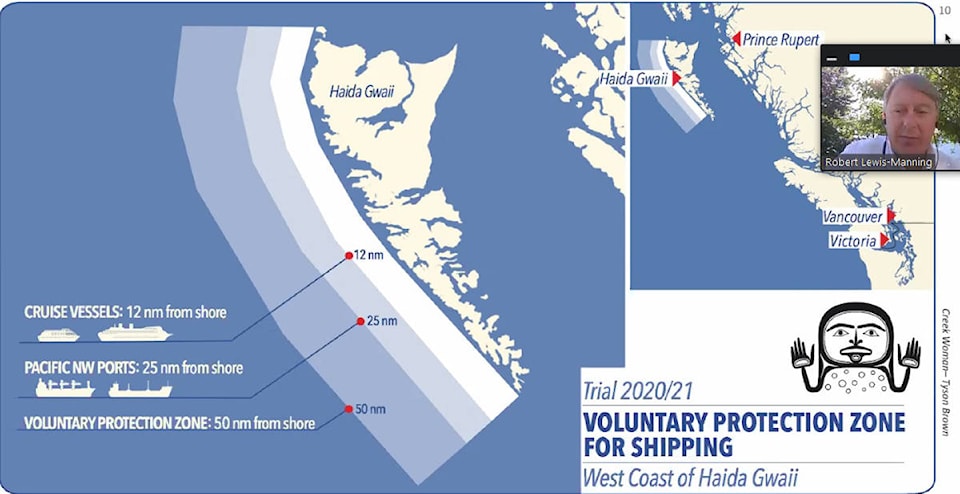The Haida Nation, federal government and shipping industry will soon embark on a voluntary shipping protection zone trial for the west coast of Haida Gwaii.
Speaking at the virtual International Marine Conservation Congress (IMCC) on Aug. 17, Haida Marine Working Group planner Russ Jones, Transport Canada’s Louise Murgatroyd and Robert Lewis-Manning of the Chamber of Shipping said the trial will start in September for a one year period.
Lewis-Manning said the trial, agreed to in June, will encourage vessels weighing 500 tonnes or more to observe a minimum distance of 50 miles from the west coast of the island with some exceptions. Vessels going between Pacific Northwest ports will be asked to observe a 25 nautical mile distance and cruise vessels will be asked to observe a 12 nautical mile distance. Tugs and barges will be exempt.
“The shipping industry will be hearing about the trial … through multiple methods,” he assured.
ALSO READ: Shoreline cleanup, sampling complete following Dinan Bay diesel spill
The importance of such a trial was made clear in 2014, Jones said, when the Russian bulk carrier vessel Simushir lost power and “came dangerously close to grounding on the west coast of Haida Gwaii.”
The Canadian Coast Guard was able to tow the incapacitated vessel away to safety, but “if the weather did not change there could have been a significant oil spill.”
To ensure adequate response time to shipping accidents and avoid spills, he said the Haida Nation and federal government had been working with the shipping industry since 2018 to encourage large vessels to transit a safe distance from the rugged western coastline of the archipelago.
“The Haida Nation was particularly interested in establishing an International Maritime Organization area to be avoided,” he said, noting the 50 nautical mile protection zone for the Aleutians as well as the 25 nautical mile protection zone for the Olympic Coast and Washington State as examples.
ALSO READ: Liberals introduce oil-tanker ban for north coast and Haida Gwaii
The Haida Nation recommended a 50 nautical mile minimum shipping protection zone based on the results of a three-year vessel traffic analysis done by Nuka Research.
Jones said the Alaskan environmental consulting firm had found that 1,000 large vessels passed within 200 nautical miles of the west coast in 2016 and 21 vessels made up 91 per cent of the traffic within 50 nautical miles.
“Vessels beyond 50 nautical miles are generally following the great circle route,” he said of the major international shipping route between North America and Asia. “Most tankers travel more than 70 nautical miles offshore in keeping with the voluntary Tanker Exclusion Zone.
“Vessels within 50 nautical miles consist largely of Alaskan cruise ships or cargo vessels.”
Tugs, fishing vessels and ferries were not included in the analysis.
ALSO READ: Haida Nation calls for shipping changes after diesel spill near Bella Bella
The voluntary Tanker Exclusion Zone, which extends from B.C. shores westward, was created in 1985 to help avoid potential oil spills. The size of the area was based on calculating the worst possible drift of a disabled tanker with a cargo, versus the time required for help to arrive.
According to the Transport Canada website, loaded oil tankers servicing the Trans-Alaska Pipeline System between Valdez, Alaska and Puget Sound, Washington must travel west of the voluntary Tanker Exclusion Zone. It does not apply to tankers travelling to or from Canadian ports and it only applies to tankers with cargo, not tankers in ballast.
Murgatroyd said the success of voluntary trials “relies very much on support and buy-in from the shipping industry.”
However, she added that using voluntary rather than regulatory approaches to proactively manage vessels has several advantages when it comes to implementation and iteration, such as shorter timelines and greater flexibility.
Correction: This story has been updated. Tugs and barges are not being asked to observe a 25 nautical mile distance. They are exempt.
Do you have something we should report on? Email:
karissa.gall@blackpress.ca.
